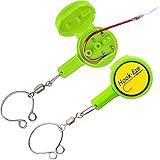Are you ready to catch some big bass? If so, then this ultimate guide is just what you need. Bass fishing can be a thrilling and rewarding experience, but it requires the right equipment and techniques. In this post, we’ll cover everything from where to go bass fishing to how to use lures effectively. Let’s get started!
Introduction to Bass Fishing
Bass are one of the most popular types of freshwater fish in North America. They are known for their size, strength, and aggressive behavior, which makes them an exciting target for anglers. There are several different species of bass, including largemouth, smallmouth, spotted, and striped bass. Each type has its own unique characteristics that make it challenging to catch.
Best Lures for Catching Big Bass
When it comes to catching big bass, there are certain lures that work better than others. Here are our top five picks:
1. Jigs – These versatile lures can be used in any water depth or condition. They have a weighted head that sinks quickly, allowing you to control your descent and retrieve.
2. Spinnerbaits – These lures feature blades that spin as they move through the water, creating vibration and flash that attracts bass. They work well in shallow waters with lots of vegetation.
3. Crankbaits – These lures imitate baitfish and are designed to dive deep into the water column. They come in various shapes and sizes, making them ideal for all kinds of conditions.
4. Soft plastics – These baits mimic live prey such as worms, crawfish, and minnows. They are soft and flexible, allowing you to manipulate them in different ways to trigger strikes.
5. Topwaters – These lures sit on the surface of the water and create noise and commotion that draws in hungry bass. They work best during low light conditions like early morning or late evening.

Where to Go Bass Fishing
One of the key factors to successful bass fishing is finding the right location. Look for areas with plenty of structure, such as rocks, logs, and weeds. Shallow waters with clear visibility also tend to hold more bass. Some great places to try include lakes, rivers, ponds, and reservoirs. Just remember to check local regulations before heading out.
How to Catch Big Bass
Once you’ve found a good spot and chosen the right lure, it’s time to start casting. Keep these tips in mind to improve your chances of landing a trophy-size bass:
1. Use proper technique – Make sure your cast lands smoothly and quietly, without causing too much disturbance in the water. Avoid jerking or twitching your rod, as this can scare off the fish.
2. Be patient – Sometimes it takes a while for the fish to strike, especially if they are hesitant or cautious. Wait for the right moment to set the hook and reel in your catch.
3. Experiment with different retrieves – Vary your speed and cadence when reeling in your line to see what works best. Try slow and steady, fast and erratic, or even pause occasionally to let the lure sink deeper.
Equipment for Bass Fishing

In addition to the right lures, you’ll also need the appropriate gear to support your efforts. This includes a quality rod and reel combo, suitable for the size and strength of the fish you’re targeting. You may also want to invest in a tackle box filled with assorted hooks, weights, and other accessories. Don’t forget about comfortable clothing, sun protection, and a reliable boat (if necessary).
What Lures to Use for Bass Fishing
As we mentioned earlier, different lures work better under specific circumstances. For example, jigs are great for bottom feeders, while spinnerbaits excel at drawing attention in shallow waters. Consider the following factors when choosing your lures:
1. Water clarity – Clear water calls for subtler colors and smaller profiles, whereas murky water allows for brighter hues and larger presentations.
2. Time of day – Early morning and late afternoon/evening typically require slower, quieter approaches, while mid-day calls for faster, noisier tactics.
3. Seasonal variations – Different times of year bring changes in weather, temperature, and food sources, affecting the behavior of bass and requiring adjustments in approach.
Teaching Your Child to Bass Fish
Fishing is a fun and educational activity that can be enjoyed by people of all ages. Teaching your child to bass fish can provide valuable lessons in patience, perseverance, and respect for nature. Start by selecting a calm body of water with easy access and few obstacles. Choose simple equipment and basic lures to avoid overwhelm. Encourage your child to ask questions and observe their surroundings, taking note of things like water clarity, depth, and structure. Finally, practice safe handling and release techniques to ensure the longevity of the sport.
How to Fish for Bass from Your Boat
If you prefer to fish from a boat, there are special considerations to keep in mind. First, choose a sturdy vessel that can handle the weight and movement of the water. Ensure that it’s properly equipped with safety gear, navigation tools, and communication devices. When casting, pay close attention to your surroundings and avoid tangling lines or snagging obstructions. Use anchors or trolling motors to maintain position and stay alert for signs of fish activity.
Conclusion
Congratulations – you now have everything you need to know to become a successful bass fisherman! Whether you’re new to the sport or looking to refine your skills, remember to stay patient, persistent, and adaptable. With the right attitude and equipment, you’re sure to land some impressive catches in no time. Good luck and happy fishing!































































